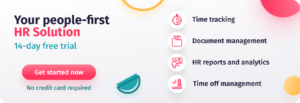One of the key roles of HR is to continuously monitor the way an organization is running to ensure that all processes and resources are performing as efficiently and productively as possible, especially in terms of a company’s employees. The best way to do this is by tracking and analyzing the right HR metrics. When managed effectively, the right metrics can help you better manage your talent so that you can build a workforce that is happy, productive, and engaged. And that’s not all. According to Deloitte, data-driven people analytics can also help you enhance your organizational decisions and drive continuous improvement in your business.
In this guide, we are going to discuss which HR metrics will help you obtain a clearer picture of the reality of your business. That way, you can make the necessary adjustments to your talent management processes and help your business grow and develop.
Importance of People Analytics
People analytics refers to the collection and analysis of all your HR metrics. The aim is to collect employee data in order to better understand your workforce and improve the way you manage and engage with your employees. Common metrics include time to hire, revenue per employee, job satisfaction, and employee growth rate. Tracking additional metrics such as training efficiency and revenue per employee can also help you quantify the return on the investment you make in your workforce.
Whichever HR metrics you choose to track, your people analytics strategy should have three main objectives:
- Help you make data-driven strategic decisions about your business.
- Enable your HR leaders to access valuable insights into your workforce so that you can improve your HR processes and activities.
- Provide you with benchmarks to measure your progress towards meeting your defined business objectives.
So, why are people analytics so important? What are the specific benefits of regularly tracking and analyzing your core HR metrics?
Put simply, tracking the right people analytics helps you make better decisions about your organization. It’s about understanding the people who work for you and how they impact your business operations. By analyzing KPIs relating to your staff you can measure the value that your policies and procedures are providing and identify areas for improvement. And this, in turn, helps you improve the employee experience, boost performance, satisfaction, and engagement, and achieve your goals as a business.
11 Valuable People Analytics HR Metrics
There are a number of different KPIs that you might need to track depending on the nature of your business. However, generally speaking, there are 11 specific HR metrics that all businesses should be monitoring on a regular basis.
These core HR metrics help you ensure that your organization is running as efficiently and profitably as possible:
- eNPS
- Time to hire
- Diversity
- Labor turnover
- Job satisfaction
- Overtime expense
- Training efficiency
- Manager effectiveness
- Quality of work
- Employee growth rate
- Revenue per employee
Let’s take a look at these valuable people analytics in a bit more detail.
eNPS
The Employee Net Promoter Score (eNPS) is a valuable HR metric used to calculate the level of employee engagement in your company. It can help you determine how happy your employees are and how committed they are to your organization. If you measure the metric over time, you can also get valuable insights into the impact of any organizational changes you may have implemented. You can then use the feedback you collect to develop strategies to improve your employee experience and boost engagement.
The process for calculating your eNPS is simple. You just have to share a survey with your employees consisting of one key question: “How likely are you to recommend your workplace to your friends and family on a scale of 0-10?” (With 10 being extremely likely and 0 being not likely at all). Employees who score a 9 or 10 are known as promoters (happy employees). Those who score a 7 or 8 are passives (neutral). And those who score between 0 and 6 are detractors (unhappy employees).
The easiest way to distribute your surveys and calculate your company’s eNPS is by using the Factorial eNPS app.
Here’s a video with a bit more information on how you can calculate your eNPS:
Time to hire
Another important people analytics metric is your time to hire. This is a KPI that you can use to measure how effective your hiring process is. This is important because if your hiring process is too slow, then you’re more likely to lose candidate interest and limit your team’s productivity. Reducing your time to hire, in contrast, can improve the candidate experience as well as your company’s employer brand.
Calculating your time-to-hire metric is simple. You just need to calculate how many days pass between receiving a successful candidate’s application and them accepting your job offer. So, for example, if you post a job on day 1, a candidate applies on day 5, and they accept your offer on day 30, then your time to hire is 25 days (30-5). Then, if your time to hire is too long, you can implement measures to help your hiring process run more efficiently so that you can attract quality talent to your business.
Labor turnover
Keeping track of your labor turnover helps you evaluate how well you are able to retain your employees. This HR metric is very important as it reflects the overall health and stability of your company. If your turnover is too high, then it suggests that your employees are not happy. And this can have a direct impact on overall productivity and engagement. It can also damage your employer brand and reputation and prevent you from hiring top talent.
To calculate your labor turnover, you need to know the following:
- The number of employees who left within a given period
- The average number of total employees within the same period
Once you’ve collected this data, you can use the following formula to calculate your current labor turnover:
Labor turnover rate (%) = (number of leavers/avg. number of employees) x 100
If the figure you get is high, you can then work on identifying the causes of your high labor turnover. Then, once you’ve implemented corrective measures, you can evaluate your rate over time to see what sort of an impact they are having on your retention and turnover levels.
Diversity
Aside from keeping track of how many people work at your organization, it’s also important to make sure that your workforce is diverse and inclusive. Including diversity metrics in your people analytics model can be a great strategy for achieving this.
Diversity metrics are the measurable numerical values that help HR identify workforce demographics and assess the efforts of the company towards inclusive practices. As with other HR metrics, diversity metrics allow you to gain insight into your workforce and the overall health of your company.
The first step with diversity metrics is understanding which ones are of the most value to you according to the specific characteristics of your workforce. Essentially, this means evaluating the demographics of your organization to determine where there is room for improvement.
For example, there might be a notable gender imbalance in certain departments, or you might uncover an issue with age bias that you need to address. You should pay particular attention to diversity metrics that relate to hiring, promotion, employee satisfaction, and retention.
Here’s a video with a bit more information on the importance of DEI data:
Job satisfaction
One of the most essential HR metrics for your business relates to job satisfaction, also known as employee satisfaction. Job satisfaction is how happy an employee is in their role. Your overall job satisfaction rate reflects your employee experience as well as the attitudes of your workforce towards your business. The higher your job satisfaction rate is, the more likely you are to have an engaged and committed staff that strives to help you meet your organizational objectives.
The job satisfaction metric is influenced by a number of aspects. These include working conditions, the relationships between employees and managers, the employee benefits you offer, and the clarity of your job descriptions and responsibilities. It’s important to work on improving all these areas. That way, you can improve your overall employee experience and develop a more satisfied workforce.
The best way to measure job satisfaction is through regular employee pulse surveys. These are brief surveys consisting of short, open-ended questions. The idea is to send them out on a regular basis. That way, you can keep your finger ‘on the pulse’ of employee sentiment.
Other important metrics that reflect employee satisfaction include turnover and absence rates. Plus, you can also gather a lot of valuable feedback by conducting regular employee reviews and appraisals.
Overtime expense HR metrics
The overtime expense metric helps you keep track of how much you are spending on overtime. Aside from helping you manage your internal budgets, this HR metric is also valuable in terms of employee engagement and productivity. This is because if your employees are regularly working long hours, they are at risk of burnout and stress. Long overtime hours also often lead to higher rates of absenteeism and increased turnover.
By monitoring your overtime expenses regularly, you can identify potential problem areas and implement measures to address them. These might include outsourcing certain tasks, automating some of your work processes, or hiring additional employees.
Training efficiency HR metrics
Training efficiency HR metrics help you evaluate how effective your learning and development initiatives are. They also help you understand how much you are investing in training, and whether the L&D you offer is driving the desired effects and boosting business performance.
You can focus on a number of aspects here:
- The number of employees who successfully complete training.
- Training assessment pass/fail rates.
- How employee performance evolves as a result of training.
- The impact of training solutions on your overall KPIs and objectives.
- Financial return ratios.
There are a number of methods you can use to determine how efficient the training you offer is. You can share post-training quizzes or tests, track training goals with specific benchmarks, or share self-assessment questionnaires. You can also collect informal feedback from peers and managers or conduct on-the-job observations to determine how training has impacted an employee’s performance. All this will help you establish whether you are getting the ROI you need from your L&D programs.
Manager effectiveness HR metrics
In order to grow and develop as a business, it’s important to have the right managers leading your teams. And this is why it’s essential to include manager effectiveness in your HR metrics dashboard.
Put simply, manager effectiveness is the ability of your leaders to help your company reach its goals. It also takes into account how effective a manager is at supporting employee development and managing employee expectations. And this requires a range of skills including leadership, communication skills, decision-making, and mentoring. It’s also vital that your managers understand what their roles entail and what you expect from them.
Here are a few examples of different HR metrics you can use to measure manager effectiveness:
- Turnover and retention per manager
- Engagement scores per manager
- Absenteeism per manager
- Team performance metrics
- Management performance review results (including 360 appraisals)
Quality of work HR metrics
The increasing popularity of remote and hybrid working models that we have seen since the pandemic has changed the way companies measure employee performance. Instead of focusing on hours in the office and employee behavior, many organizations are now evaluating quality of work by measuring specific outcomes with clear performance metrics. As a result, tools like the 9-box grid are being used more often for talent mapping and measuring performance.
The 9-box grid, also known as the 9-box assessment model, is a talent management tool used to analyze and compare employee work performance and potential. It helps managers identify future leaders. The 9-box can also be used to reevaluate talent placement, improve succession planning, and identify performance issues and talent gaps. It facilitates employee growth and contributes to retention, engagement, and productivity.
With the 9-box grid, you map your employees against two axes: current performance and future potential. Where each employee falls on the grid will depend on their combined score. The higher the score, the more potential for growth. This information can then be used to strategically develop employees for future positions within the company.
Employee growth rate
Your employee growth rate is an HR metric that reflects how much a company is either growing or shrinking according to its number of employees. This is an important metric to monitor for a number of reasons. Firstly, it helps you determine if your workforce is increasing in line with projected growth. If it’s not, then it could suggest that you have an issue with employee retention. Secondly, it’s a great tool for succession planning.
To calculate your employee growth rate for a specific period (a quarter or a year, for example), you just need to calculate an employee headcount at the start of the period (“Point A”) and at the end of the same period (“Point B”). You then subtract the headcount at Point A from the headcount from Point B, then divide this figure by your original Point A headcount. Once you’ve done that, simply multiply your result by 100 to represent it as a percentage.
Revenue per employee
The last of all the HR metrics we are discussing today is revenue per employee. This metric reflects how much revenue the average employee is generating for your business. You can calculate this by measuring the total revenue that your organization generates over a given period (usually a year), then divide this figure by your current number of employees.
You can then use your results to:
- Determine the efficiency and productivity of the average employee at your company.
- Compare revenue per employee year-on-year to see if there are any notable changes.
- Track the performance of your employees (the lower the ratio, the more likely you are to experience losses such as an unexplained high turnover rate and increased labor costs)
- Evaluate any historical changes within your organization so that you can make improvements to your operations and encourage growth through the right hiring practices, training, and retention programs.
Tracking HR Metrics with Factorial
Tacking the right HR metrics is great, but in order to get the most from the process, you need to analyze your metrics in the right way. You also need to create an effective system so that you can collect all the people analytics data you need and access insights in real-time. That way, you can use your data to predict future behaviors, measure the impact of any changes you make to your HR processes, and make better informed strategic decisions about your business.
This is where advances in workplace technology and data management tools can help you.
These days, instead of relying on intuition and manual processes for collecting employee data, most companies use HR analytics software. The right software can streamline your HR metrics data collection processes and give you access to the tools you need to accurately track, analyze, and interpret your data.
For example, if you are using Factorial’s human resources software then you will already have access to customizable and scalable reports and dashboards to help you with this. Moreover, Factorial automatically generates these reports from the information already introduced by you and your employees. This saves you a lot of time as there’s no need to manually enter your data. You can then use these custom HR reports to create effective benchmarks so that you can make informed decisions about your future business strategies. And, best of all, you can visualize your metrics and manage your reports straight from your own HR dashboard. All this makes it much easier to stay on top of your HR metrics so that you can generate the insights you need to grow your business.



